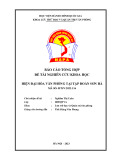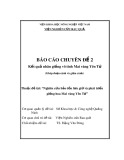
This Provisional PDF corresponds to the article as it appeared upon acceptance. Fully formatted
PDF and full text (HTML) versions will be made available soon.
Exploiting periodicity to extract the atrial activity in atrial arrhythmias
EURASIP Journal on Advances in Signal Processing 2011,
2011:134 doi:10.1186/1687-6180-2011-134
Raul Llinares (rllinares@dcom.upv.es)
Jorge Igual (jigual@dcom.upv.es)
ISSN 1687-6180
Article type Research
Submission date 4 April 2011
Acceptance date 13 December 2011
Publication date 13 December 2011
Article URL http://asp.eurasipjournals.com/content/2011/1/134
This peer-reviewed article was published immediately upon acceptance. It can be downloaded,
printed and distributed freely for any purposes (see copyright notice below).
For information about publishing your research in EURASIP Journal on Advances in Signal
Processing go to
http://asp.eurasipjournals.com/authors/instructions/
For information about other SpringerOpen publications go to
http://www.springeropen.com
EURASIP Journal on Advances
in Signal Processing
© 2011 Llinares and Igual ; licensee Springer.
This is an open access article distributed under the terms of the Creative Commons Attribution License (http://creativecommons.org/licenses/by/2.0),
which permits unrestricted use, distribution, and reproduction in any medium, provided the original work is properly cited.

EURASIP Journal on Advances in Signal Processing manuscript No.
(will be inserted by the editor)
Exploiting periodicity to extract the atrial activity in
atrial arrhythmias
Raul Llinares∗and Jorge Igual
Departamento de Comunicaciones,
Universidad Polit´ecnica de Valencia, Camino
de Vera s/n, 46022 Valencia, Spain
∗Corresponding author: rllinares@dcom.upv.es
Email address:
JI: jigual@dcom.upv.es
Abstract Atrial fibrillation disorders are one of the main arrhythmias of the el-
derly. The atrial and ventricular activities are decoupled during an atrial fibrilla-
tion episode, and very rapid and irregular waves replace the usual atrial P-wave in
a normal sinus rhythm electrocardiogram (ECG). The estimation of these wavelets
is a must for clinical analysis. We propose a new approach to this problem focused
on the quasiperiodicity of these wavelets. Atrial activity is characterized by a main
atrial rhythm in the interval 3–12 Hz. It enables us to establish the problem as
the separation of the original sources from the instantaneous linear combination of
them recorded in the ECG or the extraction of only the atrial component exploit-
ing the quasiperiodic feature of the atrial signal. This methodology implies the
previous estimation of such main atrial period. We present two algorithms that
Address(es) of author(s) should be given

2Please give a shorter version with: \authorrunning and \titlerunning prior to \maketitle
separate and extract the atrial rhythm starting from a prior estimation of the main
atrial frequency. The first one is an algebraic method based on the maximization
of a cost function that measures the periodicity. The other one is an adaptive
algorithm that exploits the decorrelation of the atrial and other signals diagonal-
izing the correlation matrices at multiple lags of the period of atrial activity. The
algorithms are applied successfully to synthetic and real data. In simulated ECGs,
the average correlation index obtained was 0.811 and 0.847, respectively. In real
ECGs, the accuracy of the results was validated using spectral and temporal pa-
rameters. The average peak frequency and spectral concentration obtained were
5.550 and 5.554 Hz and 56.3 and 54.4%, respectively, and the kurtosis was 0.266
and 0.695. For validation purposes, we compared the proposed algorithms with
established methods, obtaining better results for simulated and real registers.
Keywords Source separation ·Electrocardiogram ·Atrial fibrillation ·Periodic
component analysis ·Second-order statistics
1 Introduction
In biomedical signal processing, data are recorded with the most appropriate tech-
nology in order to optimize the study and analysis of a clinically interesting ap-
plication. Depending on the different nature of the underlying physics and the
corresponding signals, diverse information is obtained such as electrical and mag-
netic fields, electromagnetic radiation (visible, X-ray), chemical concentrations or
acoustic signals just to name some of the most popular. In many of these different
applications, for example, the ones based on biopotentials, such as electro- and
magnetoencephalogram, electromyogram or electrocardiogram (ECG), it is usual

Exploiting periodicity to extract the atrial activity in atrial arrhythmias 3
to consider the observations as a linear combination of different kinds of biolog-
ical signals, in addition to some artifacts and noise due to the recording system.
This is the case of atrial tachyarrhythmias, such as atrial fibrillation (AF) or atrial
flutter (AFL), where the atrial and the ventricular activity can be considered as
signals generated by independent bioelectric sources mixed in the ECG together
with other ancillary sources [1].
AF is the most common arrhythmia encountered in clinical practice. Its study
has received and continues receiving considerable research interest. According to
statistics, AF affects 0.4% of the general population, but the probability of de-
veloping it rises with age, less than 1% for people under 60 years of age and
greater than 6% in those over 80 years [2]. The diagnosis and treatment of these
arrhythmias can be enriched by the information provided by the electrical signal
generated in the atria (f-waves) [3]. Frequency [4] and time–frequency analysis [5]
of these f-waves can be used for the identification of underlying AF mechanisms
and prediction of therapy efficacy. In particular, the fibrillatory rate has primary
importance in AF spontaneous behavior [6], response to therapy [7] or cardiover-
sion [8]. The atrial fibrillatory frequency (or rate) can reliably be assessed from
the surface ECG using digital signal processing: firstly, extracting the atrial signal
and then, carrying out a spectral analysis.
There are two main methodologies to obtain the atrial signal. The first one
is based on the cancellation of the QRST complexes. An established method for
QRST cancellation consists of a spatiotemporal signal model that accounts for
dynamic changes in QRS morphology caused, for example, by variations in the
electrical axis of the heart [9]. The other approach involves the decomposition of
the ECG as a linear combination of different source signals [10]; in this case, it

4Please give a shorter version with: \authorrunning and \titlerunning prior to \maketitle
can be considered as a blind source separation (BSS) problem, where the source
vector includes the atrial, ventricular and ancillary sources and the mixture is
the ECG recording. The problem has been solved previously using independent
component analysis (ICA), see [1,11]. ICA methods are blind, that is, they do
not impose anything on the linear combination but the statistical independence.
In addition, the ICA algorithms based on higher-order statistics need the signals
to be non-Gaussian, with the possible exception of one component. When these
restrictions are not satisfied, BSS can still be carried out using only second-order
statistics, in this case the restriction being sources with different spectra, allowing
the separation of more than one Gaussian component.
Regardless of whether second- or higher-order statistics are used, BSS meth-
ods usually assume that the available information about the problem is minimum,
perhaps the number of components (dimensions of the problem), the kind of combi-
nation (linear or not, with or without additive noise, instantaneous or convolutive,
real or complex mixtures), or some restrictions to fix the inherent indeterminacies
about sign, amplitude and order in the recovered sources. However, it is more re-
alistic to consider that we have some prior information about the nature of the
signals and the way they are mixed before obtaining the multidimensional record-
ing.
One of the most common types of prior information in many of the applications
involving the ECG is that the biopotentials have a periodic behavior. For example,
in cardiology, we can assume the periodicity of the heartbeat when recording a
healthy electrocardiogram ECG. Obviously, depending on the disease under study,
this assumption applies or not, but although the exact periodic assumption can be
very restrictive, a quasiperiodic behavior can still be appropriated. Anyway, the




![PET/CT trong ung thư phổi: Báo cáo [Năm]](https://cdn.tailieu.vn/images/document/thumbnail/2024/20240705/sanhobien01/135x160/8121720150427.jpg)





















